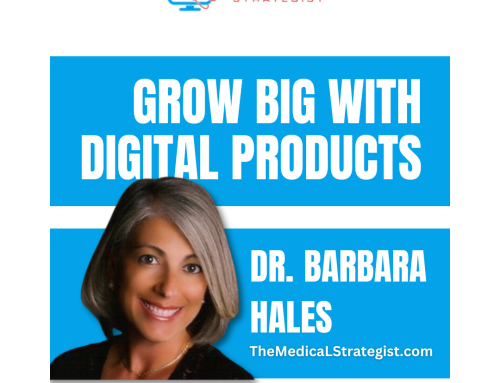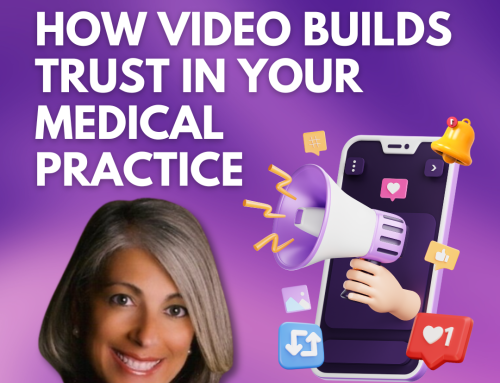Podcast: Play in new window | Download
Subscribe: RSS
In this episode, Barbara Hales and Jodi Krangle discuss:
- The critical role of voiceovers in healthcare communication.
- Challenges faced when voicing medical projects and the unique considerations required.
- How sound impacts emotional connection and accessibility in medical settings.
Key Takeaways:
- “Sound is emotion, and that’s how you reach people.” – Jodi Krangle
- Healthcare voiceovers must convey hope, warmth, and trust to connect effectively with audiences.
- AI-generated voices lack the human depth necessary for sensitive healthcare communication.
Connect with Jodi Krangle:
- Website: https://voiceoversandvocals.com
- LinkedIn: Jodi Krangle on LinkedIn
- Instagram: @jodikranglevo
- YouTube: Jodi Krangle Voiceover Artist
- Twitter: @JodiKrangle
- Facebook: Jodi Krangle Voiceover
Connect with Barbara Hales:
Twitter: @DrBarbaraHales
Facebook: facebook.com/theMedicalStrategist
Business website: www.TheMedicalStrategist.com
Show website: www.MarketingTipsForDoctors.com
Email: info@TheMedicalStrategist.com
YouTube: TheMedicalStrategist
LinkedIn: www.linkedin.com/in/barbarahales
Books:
Content Copy Made Easy
14 Tactics to Triple Sales
Power to the Patient: The Medical Strategist
TRANSCRIPTION (181)
Dr. Barbara Hales: “Welcome to another episode of Marketing Tips for Doctors. I’m your host, Dr. Barbara Hales. Today, we have a real treat. I’m joined by Jodi Krangle, a full-time voice actor since 2007, specializing in brand voice, commercials, corporate narration, and podcast intros and outros. She’s worked with clients around the world, including Dell and Kraft, and even has her own podcast about the importance of sound. Welcome to the show, Jodi!”
Jodi Krangle: “Thank you so much for having me, Barbara!”
Dr. Barbara Hales: “It’s great to have you here. You have a fascinating career. Can you share your background in voiceovers and sound design and how you got involved in the healthcare industry?”
Jodi Krangle: “I don’t do sound design, but I started voiceover work in 2007. I was volunteering with the Canadian National Institute for the Blind, reading articles onto reel-to-reel tape, which eventually sparked my interest in voiceover. After working in internet marketing for a while, I decided to focus on voiceover full-time. I’ve worked with healthcare clients for many years now, including Memorial Hospital and Joe DiMaggio Children’s Hospital. It’s been a rewarding journey.”
Challenges in Healthcare Voiceover Projects
Dr. Barbara Hales: “What unique challenges or opportunities have you encountered working on healthcare-related projects?”
Jodi Krangle: “The biggest challenge is pronouncing medical terms and drug names correctly. I also think the tone of voice in healthcare voiceovers is very important—it’s not about being doom and gloom but about offering hope. There’s a fine balance between sounding professional and offering warmth and trust.”
Creating Effective Healthcare Voiceovers
Dr. Barbara Hales: “What considerations go into creating a voiceover for healthcare settings, such as patient education videos or instructional manuals?”
Jodi Krangle: “Tone is key. Are you talking to a 65-year-old woman or a seven-year-old child? Every scenario requires a different approach. The key is to make the listener feel like you’re speaking directly to them. It’s about creating a personal connection, not just delivering information to a group.”
Dr. Barbara Hales: “Do you write your own scripts?”
Jodi Krangle: “No, usually I get a script. Often in healthcare, the script has already gone through legal, so I can’t change any words. But the challenge is to make it sound natural, even if the words don’t always sound natural in a real conversation.”
Tailoring Tone for Different Audiences
Dr. Barbara Hales: “How do you tailor your tone and delivery for different audiences, such as patients versus healthcare professionals?”
Jodi Krangle: “For patients, I use a softer, more empathetic tone. For healthcare professionals, I use a more formal tone, as they are more familiar with medical terminology. It’s about knowing who you’re talking to and adjusting the tone so that it resonates with them.”
AI vs. Human Voiceovers in Healthcare
Dr. Barbara Hales: “Do you think AI voices could ever replace human voice actors in healthcare settings?”
Jodi Krangle: “AI is improving, but it still can’t replicate the emotional connection that a human voice provides. In healthcare, where trust and empathy are vital, a human voice is far more effective than any synthesized voice.”
Ensuring Empathy and Trust in Voiceovers
Dr. Barbara Hales: “How do you ensure your voiceovers convey empathy and trust, which are so crucial in healthcare communication?”
Jodi Krangle: “It’s all about coaching and practice. As a singer, I understand how to use my instrument to make meaningful connections. It’s not just about saying the words but ensuring the meaning behind them is conveyed with empathy.”
Memorable Projects and Connection with Patients
Dr. Barbara Hales: “Are there any connections with patients that have stayed with you?”
Jodi Krangle: “I don’t have one-on-one connections since I’m usually reading a script, but I always keep in mind that I’m helping someone understand something important about their health. I think about what that person might be feeling and try to provide reassurance and hope through my voice.”
The Role of Sound in Healthcare Accessibility
Dr. Barbara Hales: “What role does sound play in enhancing accessibility for people with disabilities or language barriers in healthcare?”
Jodi Krangle: “Sound is the key to human connection. When you’re talking to someone who may be hearing or visually impaired, the voice needs to carry a message of support. AI voices can’t provide that human connection—it’s the emotional nuance in the human voice that makes a difference.”
Improving Healthcare Environments with Sound
Dr. Barbara Hales: “What’s one thing you’d change about the sound in healthcare environments?”
Jodi Krangle: “Hospitals need better sound design. Many beeping sounds are loud, stressful, and unnecessary. These sounds can disrupt recovery, so making them less alarming and more soothing would help people heal better.”
Emerging Trends in Healthcare Sound Design
Dr. Barbara Hales: “What emerging trends in sound or voiceover technology do you think will impact healthcare?”
Jodi Krangle: “I think we’ll see more efforts to use sound in healthcare branding—similar to the way companies like GE use signature sounds in their products. Hospitals or medical equipment could benefit from a calming sound that reassures patients rather than stresses them out.”
Measuring the Success of Voiceovers
Dr. Barbara Hales: “How do you measure the success or impact of your voiceovers in healthcare projects?”
Jodi Krangle: “When clients keep coming back, that’s a good sign! I’ve worked with Joe DiMaggio Children’s Hospital for nearly a decade, and I’m grateful for the relationships I’ve built in the healthcare industry.”
The Future of Healthcare Sound Design
Dr. Barbara Hales: “If resources weren’t an issue, what healthcare project would you most like to work on?”
Jodi Krangle: “I’d love to help hospitals improve their sound environments—creating sounds that support healing rather than causing stress. This could include everything from patient room sounds to the alarms and announcements made throughout a hospital.”
Conclusion
Dr. Barbara Hales: “Thank you so much for being on the show today, Jodi. It’s been a fascinating conversation about the power of sound in healthcare!”
Jodi Krangle: “Thank you, Barbara! It was a pleasure.”



